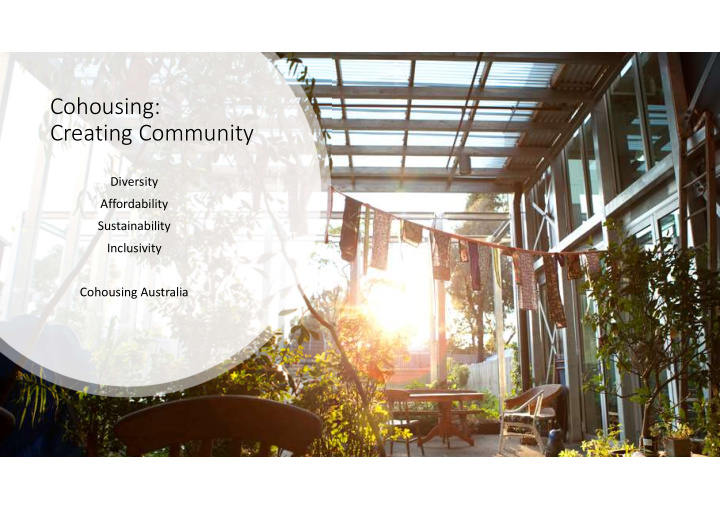



Cohousing: Creating Community Diversity Affordability Sustainability Inclusivity Cohousing Australia
Housing Security First
“Affordability” & Spatial Inequality
Food Insecurity Health Outcomes Social Isolation “The wealthier you are, the healthier you are, health data shows” The Age
Cost Implications Health Sector: (physical and mental health) Emergency Services Human Services Education Sector Infrastructure Food Insecurity Crisis Accommodation
Diverse people & households Diverse needs http://www.nonscandinavia.com/ http://justnotthesame.us/# www.skalgubbar.se
A strategy for diverse innovative housing solutions
Why is it relevant to council and councilors NOT NYMBY v YIMBY NOT Silos NOT Risk Adverse Planning NOT Post Occupancy Community Development
For Benefit Developments Individualistic = Grit True Neighborliness Sustainability Focus Participatory Design / Development Faces Not Fencers Reciprocity & Mutuality Community = Resilience
Opportunities in housing diversity: • Intergenerational housing • Older persons co-living • Student & Senior housing • Community environment for people with disabilities • Housing first approach
What is Cohousing / Intentional Communities You have your own dwelling: Living Kitchen Private Bathroom Bedrooms Private outdoor space You can choose to share: Common house Shared Gardens – native / productive Laundry Workshop / co-working / shed / library Guest rooms / teen or granny flat
Sharing: Things and chores and responsibility Equipment: • Cars / bikes / trailers • mowers / tools • camping gear Skills • IT help desk • Childcare • Cooking • Mentoring / motivation • Gardening • Workshops
Murundaka Heidelberg Heights 18 apartments • 1 bedroom to 4 bedroom Facilities: • Common house/ kitchen/dining/meeting room/ communal productive garden / open space Community benefits: workshops, tours, talks, social activities, community space Transition Town Banyule http://www.murundakacohousing.org.au/
Reducing Impact: Case Study: Murundaka http://www.murundakacohousing.org.au/
Resilient Housing Project Not segregated household solutions Building Community to foster collective resilience Key Areas: • Inclusionary Zoning / Affordable Housing • Community development lens to housing provision and planning • Affordable housing cost benefit analysis • Sustainability outcomes in high functioning communities • Reciprocity approaches to support services
Process Find Collaborators Understand the existing conditions Have a clear vision Develop policies Simulate the potential outcomes Review & evolve
LILAC – Low Impact Living Affordable Community • UK • 20 Households • Facilities: • Common house • Productive garden • Play area • Natural pond and garden • Strawbale construction • Innovative mutual home ownership scheme http://www.lilac.coop/
LILAC http://www.lilac.coop/about-lilac/site-design.html
Christie’s Walk • Adelaide • 27 Households • Apartments • Townhouses • Cottages • Facilities: • community room/library/ kitchen/dining/meeting room/ • Concepts: • Low Impact Living • Affordable • Community http://www.urbanecology.org.au/christiewalk/
Earthsong • New Zealand • 32 houses on 3 acres • 1-bedroom studios to 4 bedroom houses • 56 sqm to 122 sqm • Facilities: • Common house/play area kitchen/dining/meeting room/ communal productive garden / pond / open space • Rammed earth http://www.earthsong.org.nz/
Copper Lane • London • 6 Households • 7 adults • 6 children • No private outdoor space • Facilities: • Outdoor courtyard space • Perimeter garden spaces • Concepts: • Communal cluster http://www.archdaily.com/580881/1-nil-6-copper-lane-n16-9ns-henley-halebrown-rorrison-architects
• Reimagine the role of planning and community development What can we do? • If you started with a clean slate what would you design? • Create a vision & challenge the rules
Stay in touch https://www.facebook.com/cohousingaustralia/ elena@cohousing.org.au
Recommend
More recommend